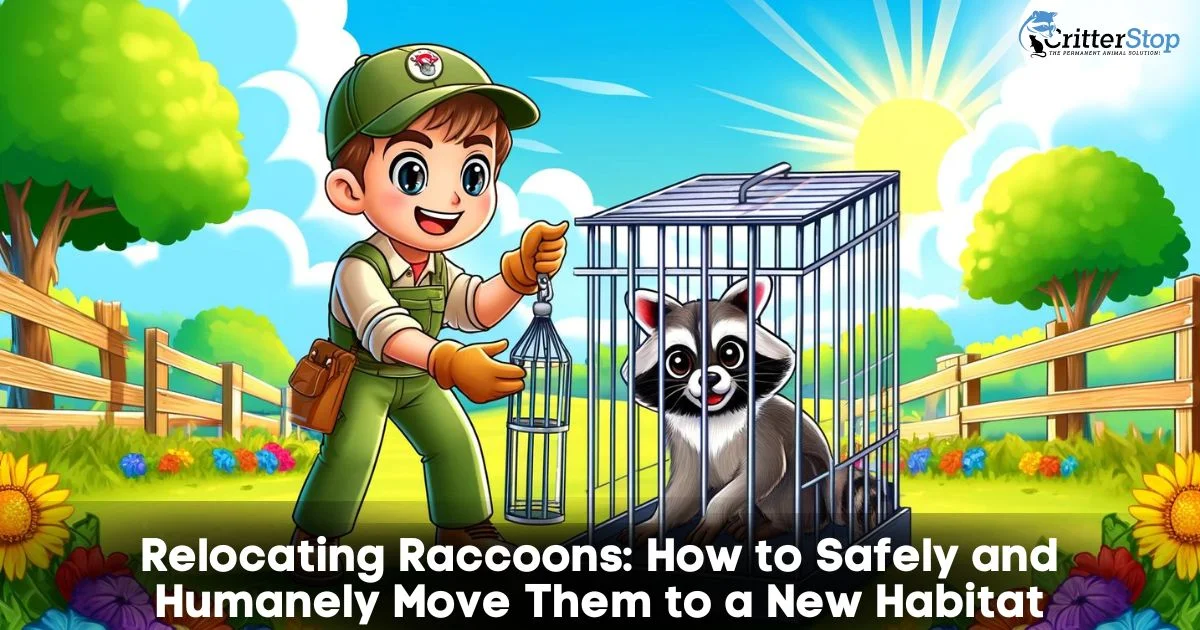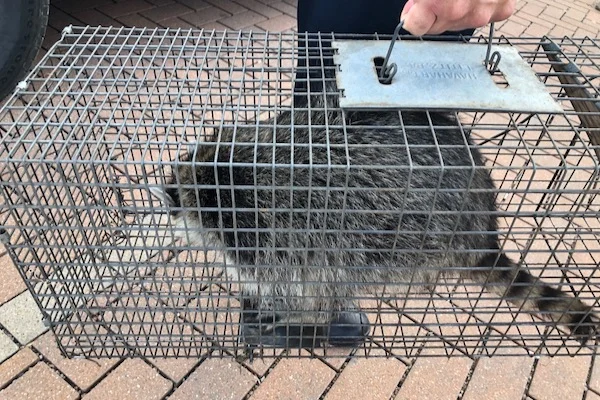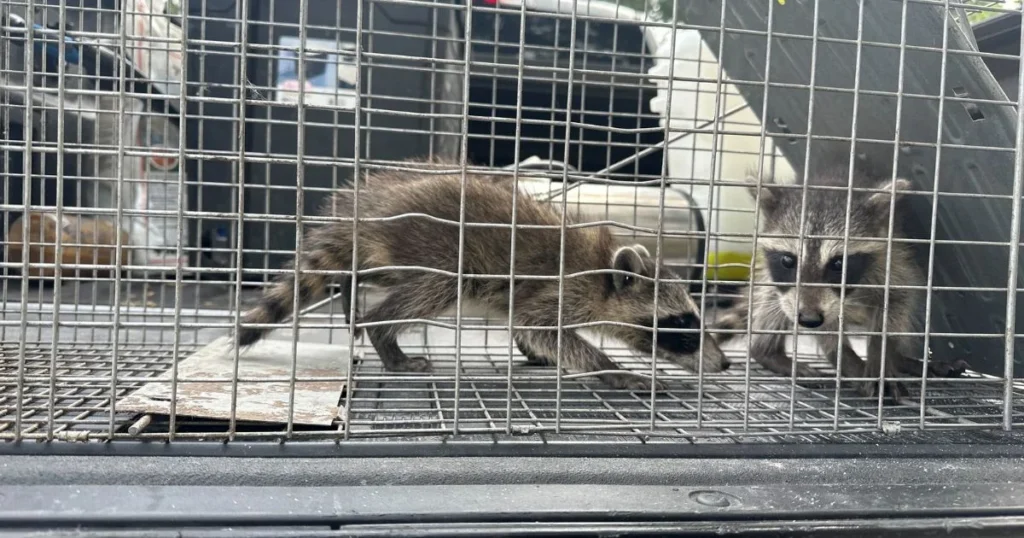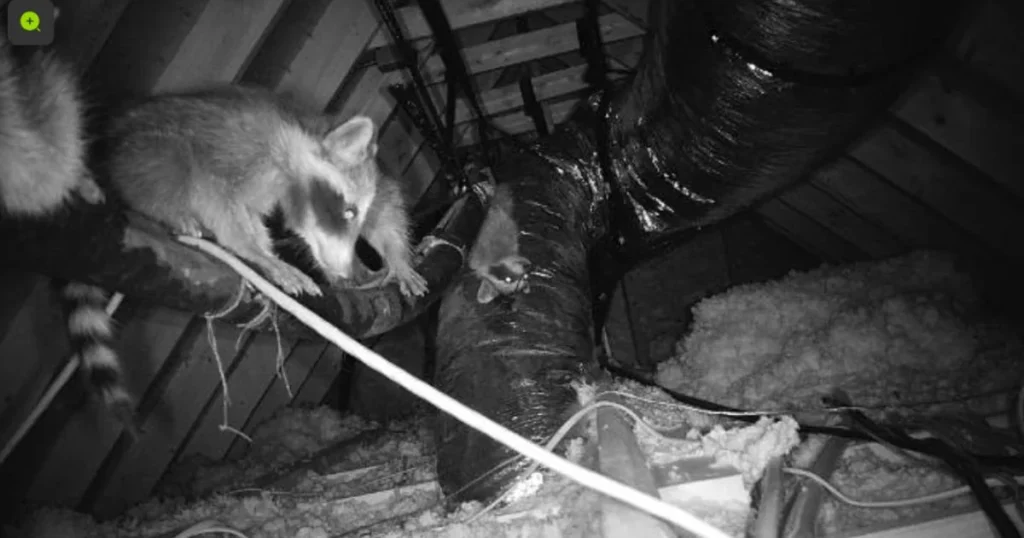
Raccoons are one of the most common wildlife species found in North America. While they are known for their cute and cuddly appearance, they can cause significant damage to property and pose a threat to human health. Consequently, numerous home and business owners are seeking methods to safely and compassionately move raccoons to new locations.
Relocating raccoons can be a challenging task, as these animals are highly adaptable and can easily find their way back to their original location. Yet, employing the correct approach and methods can lead to a successful raccoon relocation endeavor. Within this piece, we'll delve into diverse techniques for relocating raccoons, encompassing trapping and translocation, while also offering guidance on executing these methods safely and efficiently.

Raccoons are known for their territorial behavior, marking their territory with urine and feces. Additionally, they're recognized as nocturnal creatures, indicating heightened activity during nighttime hours. Throughout the day, raccoons typically seek refuge in dens situated in trees, attics, or secluded spots.
Raccoons are omnivorous creatures, consuming both plant and animal matter. They exhibit opportunistic feeding behaviors, readily consuming a wide array of food items. Their diet encompasses fruits, nuts, insects, small animals, and even refuse, showcasing their adaptable eating habits.
When raccoons are relocated from their natural habitat, they may exhibit a variety of behaviors. Some may become aggressive, while others may become depressed. It is important to understand that raccoons are highly adaptable animals and can adjust to new environments.
When relocating raccoons, it is important to choose a suitable location that provides them with food, water, and shelter. It's crucial to verify that the area is free from predators and other possible hazards.
Occasionally, employing deterrents becomes essential to deter raccoons from revisiting their initial habitat. This might involve utilizing motion-activated sprinklers or other devices emitting loud sounds or flashing lights.
Overall, understanding raccoon behavior is essential when it comes to relocating these animals. By dedicating time to understand their behaviors and requirements, it is possible to ensure a successful relocation and a positive outcome for both the raccoon and the surrounding environment.
Before relocating raccoons, it is important to understand the laws and regulations regarding wildlife relocation in your area. In some states, it is illegal to relocate raccoons without a permit. In other states, it is illegal to relocate any wildlife at all.
It is important to note that relocating raccoons without adhering to the appropriate legal protocols, you may incur fines and legal repercussions. Consulting local wildlife authorities is advisable to ascertain the laws and regulations applicable in your region.
In order to legally relocate raccoons, permits and regulations must be followed. These regulations may differ based on state and local statutes. It is important to obtain the necessary permits and follow the regulations set forth by local wildlife authorities.
Permits may require specific information such as the location of the relocation, the method of relocation, and the reason for relocation. Providing precise information and adhering to the guidelines established by local wildlife authorities is crucial.
In addition to permits, there may be regulations regarding the release of relocated raccoons. These regulations can include specific release locations and protocols to guarantee the safety of both the raccoons and the surrounding environment.
Overall, it is important to understand and follow the legal requirements for relocating raccoons. By doing so, you can safeguard the safety and welfare of both the raccoons and the surrounding environment, thereby sidestepping legal consequences.

One of the most common methods of relocating raccoons is through humane trapping. This entails employing a live trap to ensnare the raccoon and subsequently relocating it to a new area. It's crucial to utilize a trap of sufficient size to securely contain the raccoon and to regularly inspect the trap to prevent the animal from being confined for an extended duration.
When setting up a trap, it's important to position it in an area frequented by raccoons, such as near a food source or den. Bait can also be used to attract the raccoon to the trap. It is important to use a bait that is safe for the raccoon and to avoid using any type of poison.
Once the raccoon has been trapped, it is important to transport it to a new location safely. This involves placing the trap in a vehicle that is well-ventilated and secure. It is important to avoid exposing the raccoon to extreme temperatures or harsh weather conditions during transport.
When choosing a new location to release the raccoon, it is important to ensure that it is a suitable habitat for the animal. This includes providing access to food, water, and shelter. It is also important to release the raccoon in an area that is far enough away from human habitation to prevent any potential conflicts.

It's essential to acknowledge that laws and regulations governing the relocation of raccoons differ by state and country. In some areas, it may be illegal to relocate raccoons without a permit. Additionally, relocating raccoons may not always be the best solution, as it can lead to the spread of disease and displacement of other wildlife.
Before attempting to relocate a raccoon, it is important to research local laws and regulations and to consider alternative solutions, such as habitat modification or exclusion techniques. If relocation is deemed necessary, it is important to follow humane trapping and transport techniques to ensure the safety and well-being of the animal.
After relocating raccoons, it is important to monitor their survival rates to ensure that the relocation was successful. The survival rate of relocated raccoons varies depending on several factors, including the age and health of the raccoons, the location of the release site, and the availability of food and shelter.
To track the survival rates of relocated raccoons, researchers typically use radio telemetry. This involves fitting the raccoons with radio collars and tracking their movements and behavior. By monitoring the raccoons in this way, researchers can determine whether they have successfully adapted to their new environment and can locate sustenance, shelter, and potential mates.
In addition to tracking survival rates, it is important to assess how well relocated raccoons are adapting to their new environment. This can be done by monitoring their behavior and habitat use.
Researchers may use camera traps to monitor the behavior of relocated raccoons. By scrutinizing the footage recorded by these cameras, researchers can determine whether the raccoons are behaving normally and are able to find food and shelter.
Habitat assessments can also be used to determine how well relocated raccoons are adapting. Researchers may conduct surveys of the vegetation and other features of the release site to determine whether the raccoons are using the habitat in the same way as their wild counterparts.
Overall, post-relocation monitoring is an important part of the process of relocating raccoons. By tracking survival rates and assessing adaptation, researchers can determine whether the relocation was successful and make adjustments to improve the process in the future.

Securing your trash bins is one of the most efficient methods to deter raccoons from revisiting your property. Raccoons are enticed by the scent of food, and unsecured trash bins provide easy access to their favorite snacks. Use bungee cords or latches to secure the lids to prevent raccoons from accessing your trash bins. Additionally, consider using metal or plastic trash cans with tight-fitting lids to make it harder for raccoons to chew through.
Another way to prevent raccoons from returning to your property is by using home exclusion techniques. These methods entail closing off any possible entry points that raccoons could exploit to access your home. This includes sealing off gaps in your roof, walls, and foundation. Additionally, ensure all vents and chimneys are covered with mesh screens to prevent raccoons from entering.
It's important to note that simply relocating raccoons may not prevent them from returning to your property. Raccoons have a strong homing instinct and may attempt to return to their original habitat. Hence, it's vital to take preventive measures to ensure that raccoons do not return to your property in the first place.
Securing your trash bins and using home exclusion techniques can prevent raccoons from returning to your property. These methods protect your property and ensure raccoons' safety by discouraging them from becoming dependent on human-provided food sources.
If raccoons are causing problems in your yard or home, there are several strategies you can employ to discourage their return. One effective approach is to utilize motion-activated lights or sprinklers to surprise them and create discomfort. Another option is to deploy noise deterrents such as loud music or ultrasonic devices that emit high-pitched sounds that raccoons find unpleasant.
You can also use physical barriers to prevent raccoons from entering your property. This can include installing fences or using netting to cover gardens or other areas where raccoons may be causing damage. Ensuring that any barriers you utilize are secure and cannot be easily climbed or pushed aside by raccoons is crucial.
Another way to deter raccoons is to modify their habitat so that it is less attractive to them. This may involve eliminating potential food sources like bird feeders, pet food, and garbage cans. Sealing any possible entry points into your home, such as holes in the roof or walls is also essential.
Additionally, you can make your yard less hospitable to raccoons by removing potential nesting sites such as brush piles, woodpiles, and overgrown vegetation. Removing these hiding places will make raccoons less likely to choose your property as a place to call home.
Overall, several effective alternatives to relocating raccoons can help you manage their presence on your property. Using a combination of deterrents and habitat modifications, you can establish an environment that is less appealing to raccoons and reduce the likelihood of conflicts between humans and wildlife.
When relocating raccoons, it is important to consider their welfare. Raccoons are wild animals, and they may become stressed or injured during the relocation process. To minimize the impact on the animals, it's essential to utilize humane traps and handle them with care. These traps should be checked regularly to prevent raccoons from being confined in them for extended periods.
Relocating raccoons can have an impact on the ecosystems they are moved to. Raccoons are opportunistic feeders and can disrupt the balance of an ecosystem by preying on native species or damaging vegetation. It is important to consider the impact on the ecosystem before relocating raccoons and ensure that they are moved to an appropriate location.
To ensure that raccoons are relocated safely and humanely, it is recommended to call a professional wildlife removal service like Critter Stop. We have the expertise and equipment to relocate raccoons without posing any threat to their well-being or the ecosystem. Critter Stop also offers preventative measures to avoid future raccoon infestations. Contact us at (214) 234-2616.
In conclusion, relocating raccoons requires careful consideration of their welfare and the impact on ecosystems. By using humane traps and seeking professional assistance, it is possible to relocate raccoons safely and effectively.
Before relocating raccoons, it is important to check with local laws and regulations. In certain regions, it might be against the law to trap and relocate raccoons without obtaining a permit or license. Additionally, some areas may have specific guidelines for where and how raccoons can be relocated. It is important to follow all legal requirements to avoid any legal issues.
Yes, raccoons can be relocated; however, it is important to follow proper procedures to ensure their safety and prevent their return. It's advisable to enlist the services of a professional wildlife removal company to manage the relocation process, as they have the necessary experience and equipment to safely relocate raccoons.
When relocating raccoons, it is recommended to relocate them at least 10 miles away from their original location to prevent their return. However, it's important to note that raccoons are highly adaptable and may find their way back to their original location if they are not relocated far enough away.
In certain regions, trapping and relocating may be against the law raccoons without a permit or license. It is important to check with local laws and regulations before attempting to relocate raccoons. Violating these laws can result in fines or other legal consequences.
Raccoons have a strong homing instinct and may attempt to return to their original location if they are not relocated far enough away. It is important to relocate raccoons at least 10 miles away from their original location to prevent their return. Additionally, it is recommended to make the original location less appealing to raccoons by removing any food or shelter sources.
The survival rate of relocated raccoons can vary depending on various factors such as the age and health of the raccoons, the distance of relocation, the availability of suitable habitat, and the presence of predators or competition in the new area. However, studies have shown that the survival rate of relocated raccoons tends to be lower compared to those that remain in their original habitat.
Visit our Critter Library and learn more about our furry friends